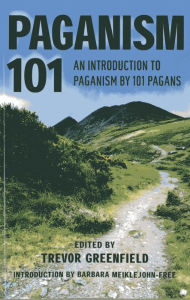When someone asks me “What’s a Pagan?”, it can be a very hard question to answer. Like Christianity, which has many different sects, Paganism has a number of important religious traditions under its “umbrella”, including druidry, heathenry, Wicca, Witchcraft, and a number of others. And if you ask any one Pagan what their religion is about, you are going to receive answers that vary wildly from person to person.
Paganism 101 is a collection of articles from different Pagan traditions organized by theme. It’s divided into three main parts: “Who We Are”, “What We Believe”, and “What We Do”. It’s further separated into different categories with an introduction of a number of the different Pagan “paths”, and specific chapters on nature, the afterlife, and various aspects of spellwork such as herbalism, ritual, and healing.
One section of the book that took me by surprise addressed “Christo-Pagans”, a term that encompasses those who choose Jesus as a God and Mary as a Goddess, generally speaking. I’ve met quite a number of folks who follow it, and it appears to be becoming quite popular. Both Pagans and Christians say that you cannot be both Pagan and Christian, a number of stories in this book would show you that this is not the case.
As I looked through the table of contents, the Ethics portion of Part 2 jumped out at me immediately. This is often a very interesting area to look at, as each different path or tradition in the umbrella could have its own moral code. Some of the more universal themes include belief in the threefold law—both good and bad are returned to you three times as good or bad—respect for the earth, and openness toward human sexuality in whatever form it takes.
Of all of the ethics articles, Mary Caelsto wrote the one I liked the most and it really resonated with me. Having different moral codes does not absolve us from personal responsibility, and to allow bad behavior to occur without consequence means that we are not following our own code. We must accept the consequences our actions have not only on ourselves, but also on those around us. It’s a simple and profound message that modern Pagans need to hear.
One of the things I like most about this book is that it welcomed all paths and put them on an equal footing. I’ll say right now that as I read through this book, there were things I didn’t agree with. If you are a practicing Pagan and you read this book, you are going to have the same thing happen. I look at that as a good thing. You don’t have to agree with every practice of another Pagan path; you just have to respect that what they are doing is every bit as valid as what you are doing.
Overall, I liked this book and think it makes a great reference, especially for those who are considering different Pagan traditions. But reading this book really showed how similar many of the paths truly are.
Editor: Trevor Greenfield
Moon Books, 2014
$18.95
Paganism 101: An Introduction to Paganism by 101 Pagans

©
2010 - 2025
Facing North
